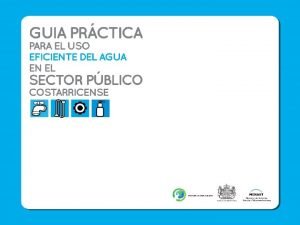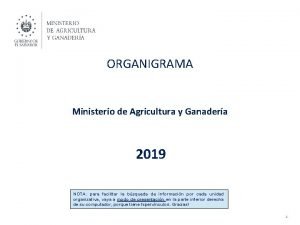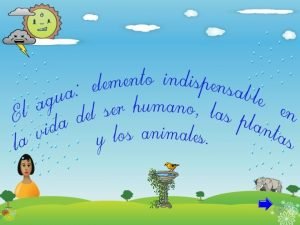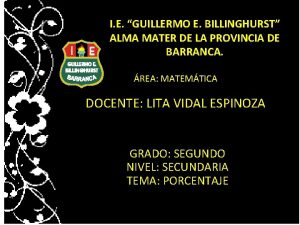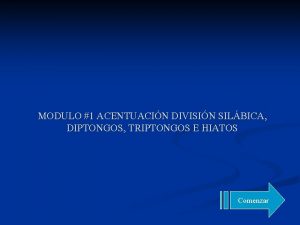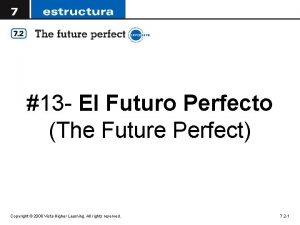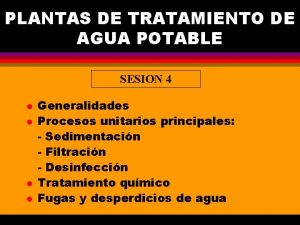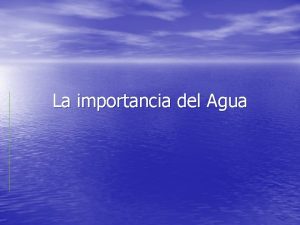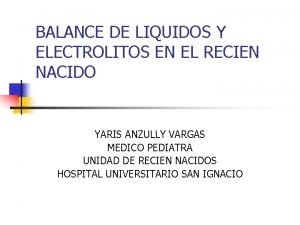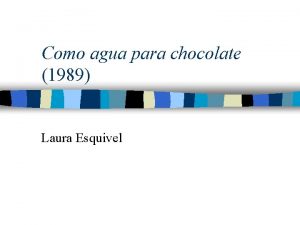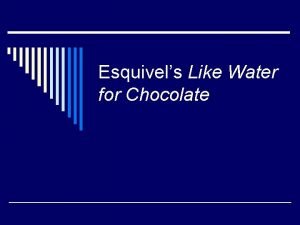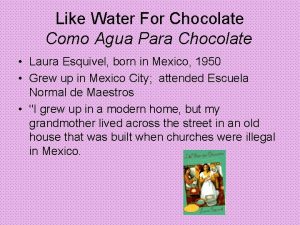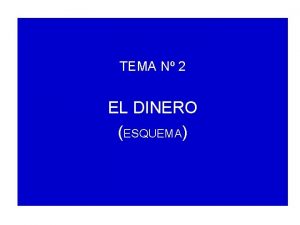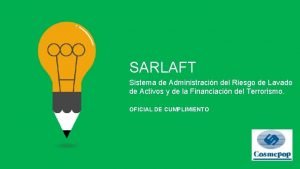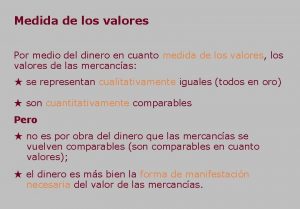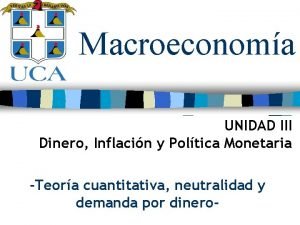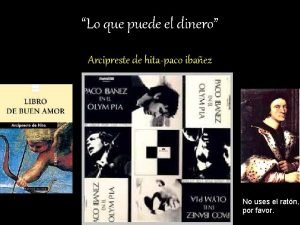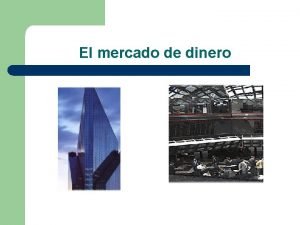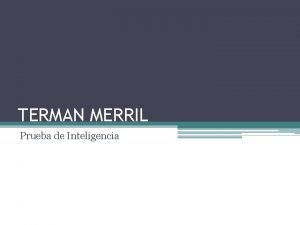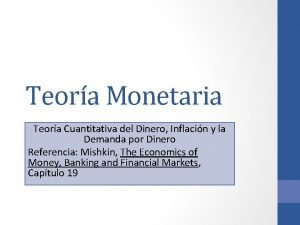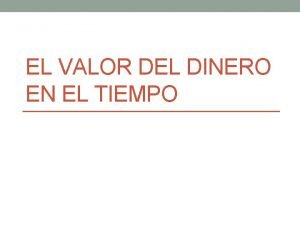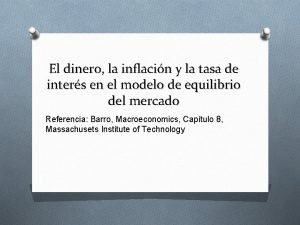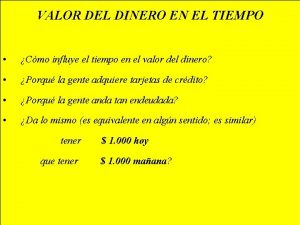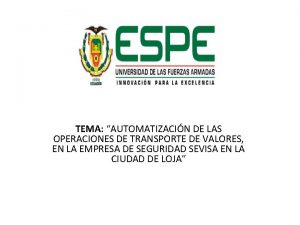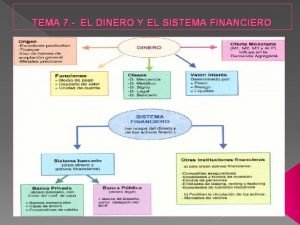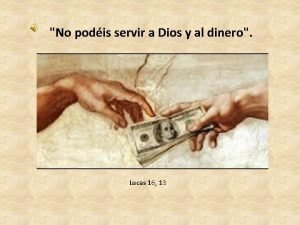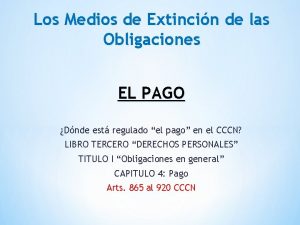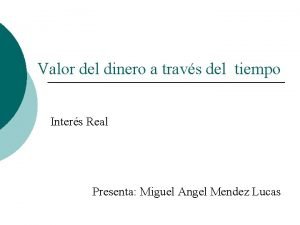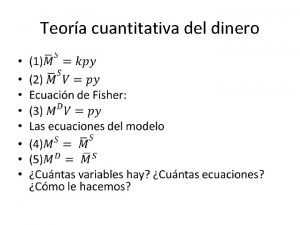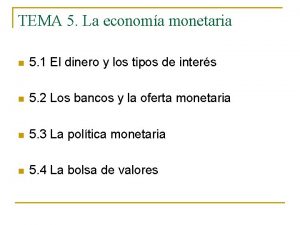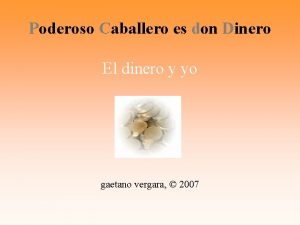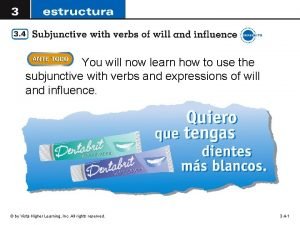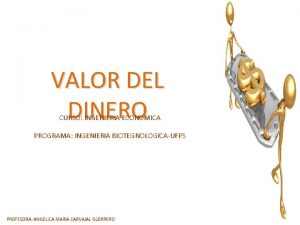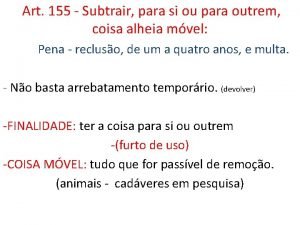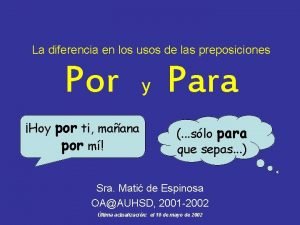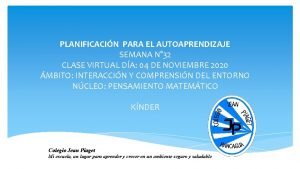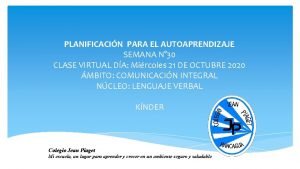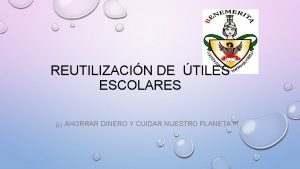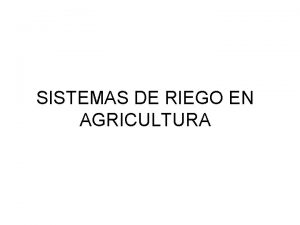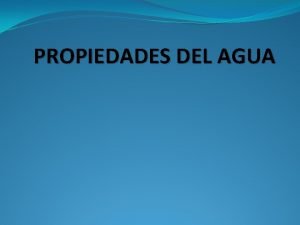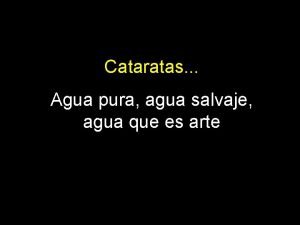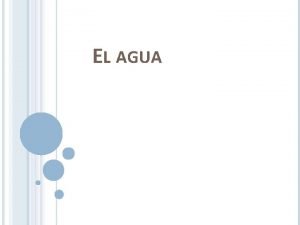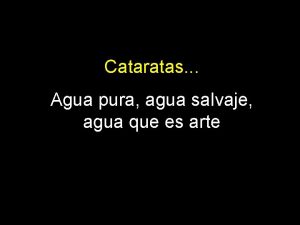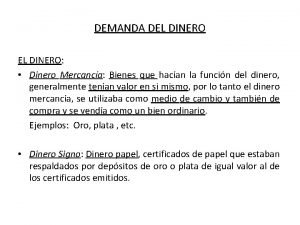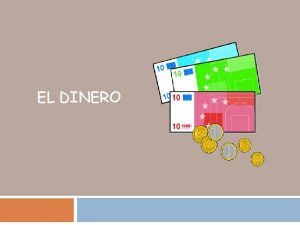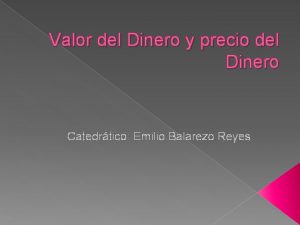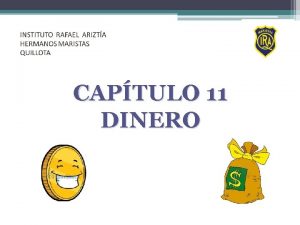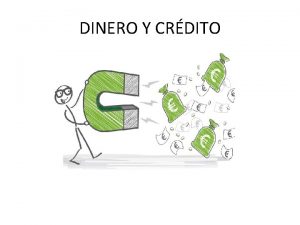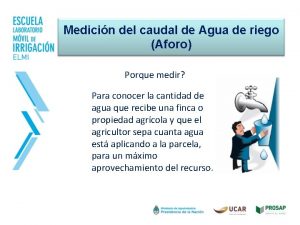Planificacio n de riego para ahorrar dinero agua
































































- Slides: 64

Planificacio n de riego para ahorrar dinero, agua y energi a Dr. Eric Harmsen Professor, Dept. of Agricultural and Biosystems Eng. , Univ. of Puerto Rico-Mayaguez Eric. harmsen@upr. edu (787)955 -5102 Taller de Riego Juana Diaz, Puerto Rico, Marzo 12, 2014

ACKNOWLEDGEMENT �Colegio de Ciencias Agrícolas, Universidad de Puerto Rico �Agro Servicios Inc. �USDA Hatch Project (H-402) �NOAA-CREST Project

Irrigation Scheduling What is the problem? �There is anecdotal evidence that most farmers do not use scientific methods for scheduling irrigation Data from Idaho, USA http: //www. webpages. uidaho. edu/~karenl/wq/wqbr 26. html

Definition �What is irrigation scheduling? Irrigation Scheduling is the process used by irrigation system managers (farmers) to determine the correct frequency and duration of watering. (wikipedia. org)

Why do we care? Over application of water Under-application of water �Leads to the waste of � Leads to � crop water stress � Reduced crop yield � loss of revenue to the grower � water � energy � chemicals � money � may lead to the contamination of ground and surface waters. � leaching of fertilizers past the root zone � water logging � lower crop yields.

How much money are we talking about? Cultivo* Gandules Pepinillo Repollo Sandia Platanos y Guineos, Plantilla Calabaza Cebolla Pimiento Barenjena Platanos y Guineos, Reton~o Melon, Cantaloupe y Honeydew Raices y Tuberculos 0. 4 0. 5 47 111 256 293 318 390 543 578 757 1, 006 1, 027 1, 041 32 76 174 199 216 265 369 393 514 684 698 707 Relative Irrigation Applied 0. 8 1. 0 1. 3 $ Lost / Cuerda 10 0 12 25 0 15 57 0 21 65 0 23 71 0 24 87 0 27 121 0 34 129 0 36 169 0 44 225 0 76 229 0 56 232 0 57 1. 5 1. 8 35 56 103 114 122 146 195 206 264 388 352 356 69 124 247 277 299 359 490 519 670 945 899 911 *Based model budget data from the Conjunto Tecnológico, UPR Experment Station

Objective �To review several important soil and water concepts related to irrigation management �To introduce several methods of scheduling irrigation

METHODS �Experience Method �Water Supply Method �Evapotranspiration Method �Soil Moisture Method �Water balance method

Experience Method �“I apply 1 inch of water to my crop every week. ” �“The soil looks dry so I am going to irrigate. ” �“The crop looks stressed so I am going to irrigate. ”

Water Supply Method �The farm receives a certain amount of water on dates that are already fixed in advance. �The method takes into account the average rainfall only and thus does not take into account the actual rainfall; �this results in over-irrigation in wetter than average years and under-irrigation in drier than average years. �This method is commonly used with surface irrigation systems. http: //www. fao. org/docrep/t 7202 e 06. htm

Evapotranspiration (ET) Method 1. Simple method (if you are currently not doing anything). http: //www. fao. org/docrep/s 2022 e 02. htm

600 Cumulative ETc vs. Irrigation a Cumulative ETc or Irrigation/ Rainfall (mm) 500 r e v O Cumulative ET 400 300 n tio ic l p Ap Cumulative Irrigation/Rainfall n tio a ic l r e nd 200 p p A U 100 0 3/2/08 3/22/08 4/11/08 5/1/08 Date 5/21/08 6/10/08

TABLE 1. AVERAGE DAILY WATER NEEDS (MM) OF STANDARD GRASS DURING IRRIGATION SEASON

CROP WATER NEEDS IN PEAK PERIOD OF VARIOUS FIELD CROPS AS COMPARED TO STANDARD GRASS

http: //www. ianrpubs. unl. edu/epublic/live/g 1994/build/graphics/g 1994 -2. jpg

Example of simple ET method �Crop: Sugar cane �Location: Aguada, Puerto Rico �Area: 50 cuerda �Determine the irrigation requirement for one week during the peak of the growing season. �Pump flow rate is 1000 gpm �Assume irrigation system is 75% efficient

TABLE 1. AVERAGE DAILY WATER NEEDS (MM) OF STANDARD GRASS DURING IRRIGATION SEASON

CROP WATER NEEDS IN PEAK PERIOD OF VARIOUS FIELD CROPS AS COMPARED TO STANDARD GRASS

Calculations �From Table 1: Water need for standard grass is 7 mm �From table 2: add 20%. � 1. 2 x 7 mm/day x 7 days = 59 mm �Calculate total gallons: � 59 mm x 50 cuerda x 1044 / 0. 75 = 4, 090, 000 million gallons �Pumping time: � 4, 090, 000 gal/1000 gal/min *60 min/hr = 68 hours

Evapotranspiration Method 2. Web-based ET method �http: //pragwater. com/daily-referenceevapotranspiration-eto-for-puerto-rico-hispaniolaand-jamaica/

http: //pragwater. com/2012/03/29/simple-irrigation-scheduling-toolfor-puerto-rico/

Web-based method for irrigation scheduling in PR Start Define problem (location, farm size, crop, etc. ) Determine average Kc for the time period Determine rainfall from onsite gauge or NEXRAD Determine ETo Estimate Crop Water Requirement ETc = Kc ETo Harmsen E. W. , 2012. TECHNICAL NOTE: A Simple Web -Based Method for Scheduling Irrigation in Puerto Rico J. Agric. Univ. P. R. 96 (3 -4) 2012. Estimate Irrigation Requirement and required hours of pumping

Detailed Example �Determine the irrigation requirement for the 5 day period, February 15 -19, 2012, for a tomato crop in Juana Diaz, Puerto Rico. Required Hyperlinks Length of Growth Stages (Table 11) and Crop Coefficients (Table 12) http: //www. fao. org/docrep/X 0490 E/x 0 490 e 00. htm Daily Reference Evapotranspiration (ETo) http: //academic. uprm. edu/hdc/GOESPRWEB_RESULTS/rainfall Daily NEXRAD Rainfall for Puerto Rico http: //academic. uprm. edu/hdc/GOESPRWEB_RESULTS/reference_ET/

Step 1. Information used in example problem.

Step 2. Crop growth stage and crop coefficient data for example problem. http: //www. fao. org/docrep/X 0490 E/x 0490 e 00. htm Tomato Growth Stages and Crop Coefficients

Crop Coefficient �The averge Kc value of 0. 85 for the five day period was obtained. Crop coefficient curve for the example problem. The heavy dashed line applies to the example problem with day of season 46 -50 (i. e. , Feb 15 -19) corresponding to an approximate crop coefficient of 0. 85 (vertical axis).

Step 3. Rainfallhttp: //academic. uprm. edu/hdc/GOESPRWEB_RESULTS/rainfall/ • Inspection of the rainfall maps at the URL provided indicates that there was no rainfall during the five day period.

Step 4. Reference Evapotranspiration (ETo) http: //academic. uprm. edu/hdc/GOESPRWEB_RESULTS/reference_ET/ �Inspection of the ETo maps at the URL provided above indicates that there was 16. 1 mm of ETo during the five day period.

Step 5. Crop Water Requirement • The crop water requirement (ETc) for the five day period can now be estimated as follows: ETc = Kc ETo = (0. 85)(16. 1 mm) = 13. 7 mm

Step 6. Calculation of Irrigation Requirement and duration of pumping �Using D = ETc = 13. 7 mm �A = 10 acres �Q = 300 gallons per minute �eff = 0. 85, yields: �Irrigation Requirement (volume) 13. 7 mm x 10 cuerda x 1044 / 0. 85 = 168, 260 gallons �Pumping time: 168, 260 gal/300 gal/min *60 min/hr = 9. 35 hours

Web-based Irrigation Scheduling Tool �Students from the Computer Engineering Department are developing desktop and mobile apps of the web-based irrigation scheduling procedure. �The user will be able to create an account, which will remember the user irrigation history �Everything will be automated �The apps should be ready for use in approximately 3 months.

Puerto Rico Evapotranspiration Computer Program http: //pragwater. com/crop-water-use/

PRET

Soil Moisture Methods Maintain soil water between θFC and θt

Soil Water Reservoir AIR VOLUME WATER VOLUME SOLID VOLUME

Water Volume DRAINABLE WATER TOTAL AVAILABLE WATER IMMOBILE WATER

Total Available Water READILY AVAILABLE WATER TOTAL AVAILABLE WATER

Soil Water Pressure The Soil Water Characteristic Curve TOTAL AVAILABLE WATER Volumetric Soil Moisture Content (θ)

Total Available Water TAW = θFC - θWP where θFC = Volumetric moisture content a the field capacity θWP = Wilting point volumetric moisture content.

Representative Physical Properties of Soils

Soil Water Pressure The Soil Water Characteristic Curve RAW d l ho s re h T Volumetric Soil Moisture Content (θ)

Readily Available Water �Plants can only remove a portion of the available water before growth and yield are affected. This portion is the “readily available water” (RAW). �For most crops RAW is between 20% to 65% �RAW is estimated from the following formula: RAW = (MAD) (TAW)

Management Allowed Deficit (MAD) MAD

Threshold Moisture Content, θt • If the soil moisture content falls below θt , the crop will go into stress and you will loss crop yield! θt = θFC – RAW where θt = threshold moisture content θFC = field capacity moisture content RAW = readily available water

Soil Water Pressure The Soil Water Characteristic Curve NO STRESS d l ho s re h T Volumetric Soil Moisture Content (θ) LOST

Maintain soil water between θFC and θt

Soil Moisture Method �Perhaps the best method because it considers the readily available water in the soil. �Gravimetric method �Tensiometers �Electrical method �Water balance method

Gravimetric Soil Sampling

Tensiometers

Time Domain Reflectometry TDR

Capacitance Method

Maintain soil water between θFC and θt

Water Balance Method θt 2 = R + Irr – RO – ETc adj – PERC + θt 1 θt 2 = volumetric moisture content at time 2 θt 1 = volumetric moisture content at time 1 R = effective rainfall RO = runoff PERC = water that percolates past the root zone

http: //pragwater. com/2011/12/17/a-simple-irrigationscheduling-spreadsheet-program/

Soil Water Management Spreadsheet http: //pragwater. com/2011/12/17/a-simple-irrigation-scheduling-spreadsheet-program/ User must enter the yellow spreadsheet cells



Crop Stress Factor Vs. Time 1. 05 Crop Stress Factor, Ks 1. 00 0. 95 0. 90 0. 85 0. 80 3/13/2008 3/18/2008 3/23/2008 3/28/2008 DATE 4/2/2008 4/7/2008 4/12/2008


Soil Moisture Content Vs. Date 38. 00 Field Capacity Moisture Content, θFC 36. 00 34. 00 Moisture Cotent (%) 32. 00 30. 00 28. 00 26. 00 24. 00 22. 00 20. 00 3/13/2008 Crop is in stress When moisture Content is below this line!! 3/18/2008 3/23/2008 3/28/2008 Date Threshold Moisture Content, θt 4/2/2008 4/7/2008 4/12/2008

Crop Stress!

Irrigation Application Rate and Timing

Conclusion Maintain soil water between θFC and θt

Gracias! For help with any of the methods covered in today’s presentation, please contact me by email at eric. harmsen@upr. edu
 Por que es importante ahorrar agua
Por que es importante ahorrar agua Organigrama de ministerio de agricultura
Organigrama de ministerio de agricultura Frases para cuidar el agua para niños
Frases para cuidar el agua para niños Piensa tiene diptongo
Piensa tiene diptongo Ahorrar en oro
Ahorrar en oro Tenázmente
Tenázmente Qué porcentaje de los caracoles han cruzado la línea
Qué porcentaje de los caracoles han cruzado la línea Palabras triptongos
Palabras triptongos Para el sabado nosotros habremos obtenido el dinero
Para el sabado nosotros habremos obtenido el dinero Proyecto agua potable rural
Proyecto agua potable rural Floculadores para agua potable
Floculadores para agua potable Que importancia tiene el agua para la vida
Que importancia tiene el agua para la vida Profesora
Profesora Calculo de agua endogena
Calculo de agua endogena Perdidas insensibles
Perdidas insensibles Principio de tales de mileto
Principio de tales de mileto Biografia de laura esquivel como agua para chocolate
Biografia de laura esquivel como agua para chocolate Ciclo del agua
Ciclo del agua Magic realism in como agua para chocolate
Magic realism in como agua para chocolate Como agua para chocolate mexican revolution
Como agua para chocolate mexican revolution Una persona siempre tiene cuerpo gorra guantes boca dinero
Una persona siempre tiene cuerpo gorra guantes boca dinero Esquema de los valores
Esquema de los valores Etapas del lavado de dinero
Etapas del lavado de dinero Medida de valores y patrón de precios
Medida de valores y patrón de precios Dinero de alto poder
Dinero de alto poder Lo que puede el dinero analisi
Lo que puede el dinero analisi Caracteristicas mercado de dinero
Caracteristicas mercado de dinero El dinero nos puede dar:
El dinero nos puede dar: Yo tengo el dinero direct object pronoun
Yo tengo el dinero direct object pronoun No cobraras interes a tu hermano
No cobraras interes a tu hermano Etapas del lavado de activos
Etapas del lavado de activos Una persona siempre tiene cuerpo gorra guantes boca dinero
Una persona siempre tiene cuerpo gorra guantes boca dinero Ecuación cuantitativa
Ecuación cuantitativa Introducción del dinero
Introducción del dinero Nosotros _____ (querer) mucho dinero*.
Nosotros _____ (querer) mucho dinero*. Teoria neocuantitativa del dinero
Teoria neocuantitativa del dinero Valor futuro de un ingreso mixto
Valor futuro de un ingreso mixto Tasa de crecimiento del dinero
Tasa de crecimiento del dinero Dinero en el tiempo
Dinero en el tiempo Empresa de transporte de dinero
Empresa de transporte de dinero El dinero y el sistema financiero
El dinero y el sistema financiero Agradecer no cuesta nada pero vale mucho
Agradecer no cuesta nada pero vale mucho Si quieres saber el valor del dinero pidelo prestado
Si quieres saber el valor del dinero pidelo prestado Servir a dios y al dinero
Servir a dios y al dinero Ya resuelto
Ya resuelto El dinero nos puede proporcionar
El dinero nos puede proporcionar Significado denotativo de primera
Significado denotativo de primera Lo importante acerca del dinero
Lo importante acerca del dinero Uso responsable del dinero
Uso responsable del dinero El valor del dinero en el tiempo
El valor del dinero en el tiempo Ecuacion cuantitativa del dinero
Ecuacion cuantitativa del dinero Qué es el dinero mercancía
Qué es el dinero mercancía Todos bailaron en la noche la clase de pronombre es
Todos bailaron en la noche la clase de pronombre es Buen caballero es don dinero
Buen caballero es don dinero Te sugiero que ir con ella al supermercado
Te sugiero que ir con ella al supermercado Te sugiero que (ir) con ella al supermercado.
Te sugiero que (ir) con ella al supermercado. Valor del dinero en el tiempo ingenieria economica
Valor del dinero en el tiempo ingenieria economica Carnet de cientifico para niños para imprimir
Carnet de cientifico para niños para imprimir Nacimos para ser felices no perfectos
Nacimos para ser felices no perfectos Unesp em uma obra para permitir
Unesp em uma obra para permitir Consumir para viver ou viver para consumir
Consumir para viver ou viver para consumir Subtrair para si ou para outrem coisa alheia móvel
Subtrair para si ou para outrem coisa alheia móvel Usos de las preposiciones
Usos de las preposiciones Reglas para clases virtuales para niños camara encendida
Reglas para clases virtuales para niños camara encendida Reglas para clases virtuales para niños camara encendida
Reglas para clases virtuales para niños camara encendida
